How to grow chives – enjoy success with these multipurpose herbs both outdoors and indoors
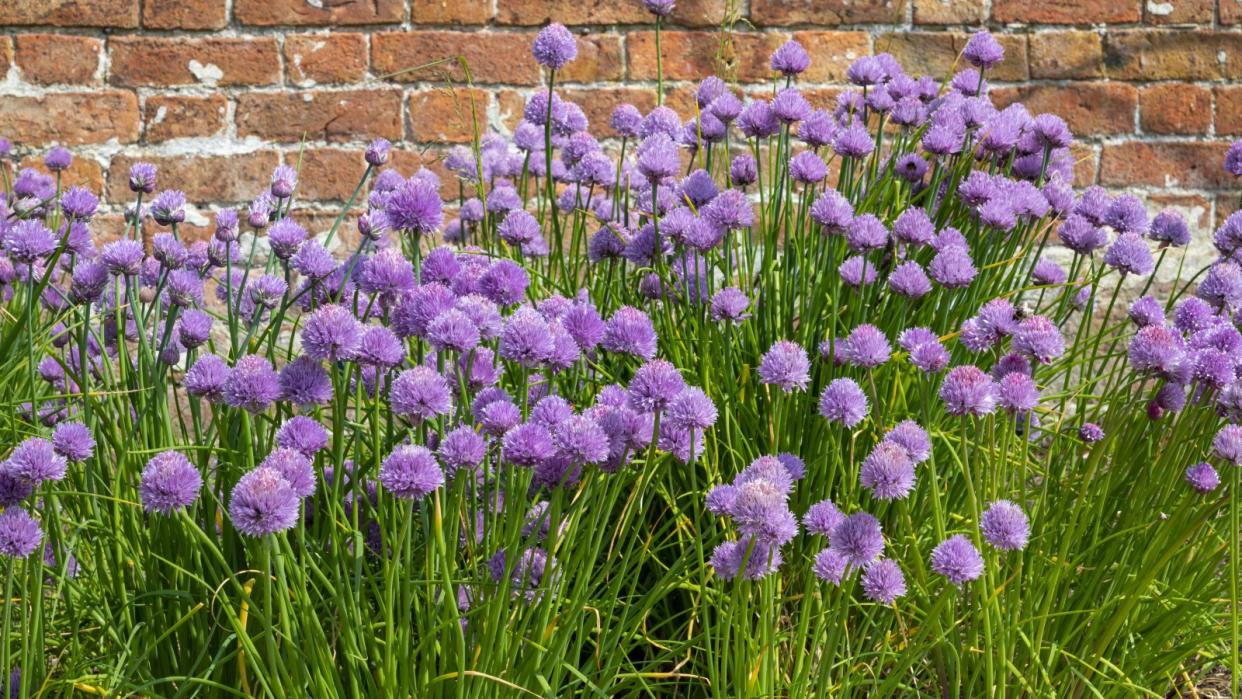
Chives are a hugely useful and popular perennial herb, often a mainstay in many people’s herb garden ideas, as well as in vegetable gardens. It is a plant perfectly suited to growing in pots, lining edges in the yard, or even thriving indoors on a sunny windowsill.
One of the reasons they are so much-loved is due to their simplicity, they are easy to grow and require little maintenance each year. Their stems are harvested and used in salads, sauces, and more, while their edible blooms can brighten up dishes as a colorful garnish.
Chives can be grown as young plants or grown from seed with little fuss while existing clumps can be split to get more chives for your garden. Chives are an all-round fantastic plant to utilize in any growing space.
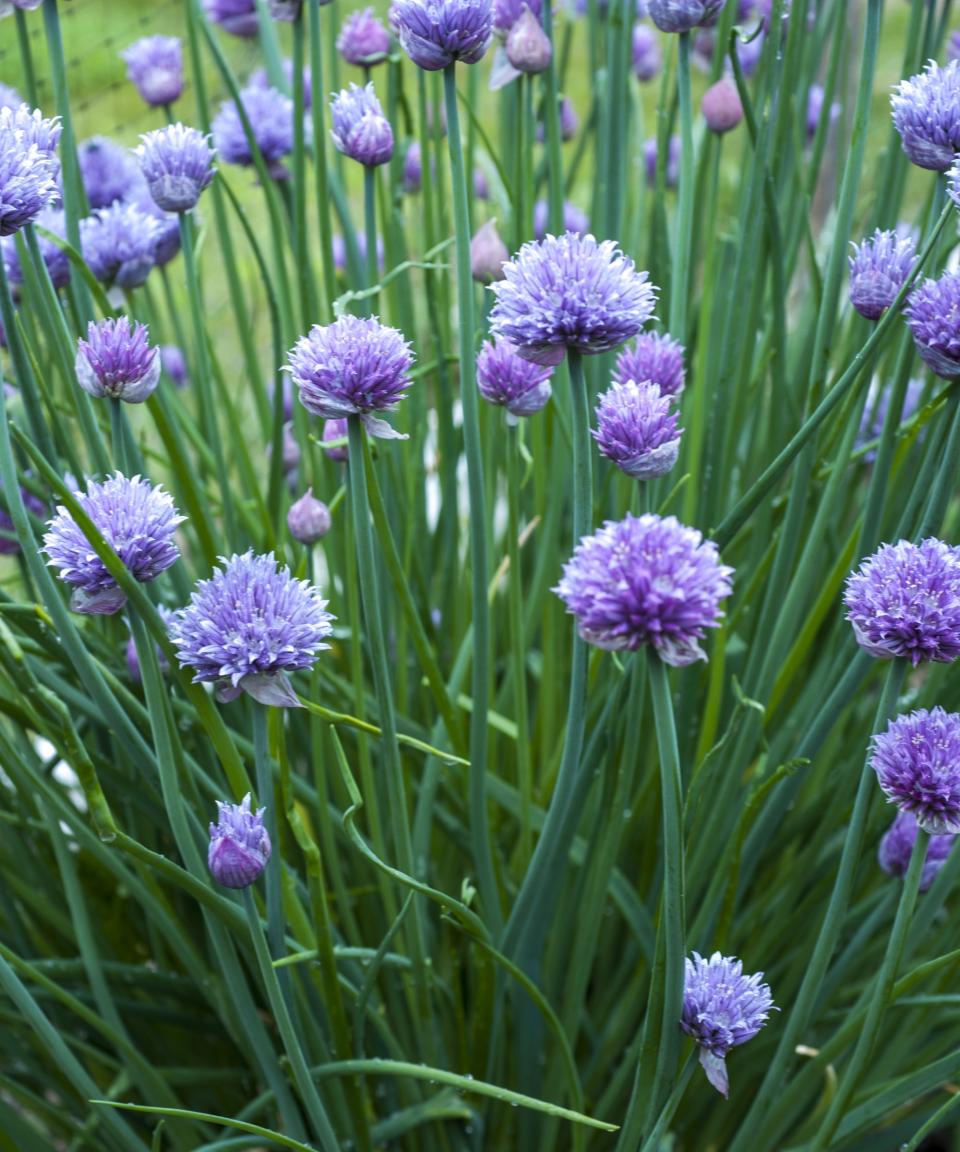
Types of chives
The most common type of chives that you see widely available is Allium schoenoprasum. The plant produces clumps of slender and upright tubular and hollow stems, reaching eight inches and with spherical purple flowers on stalks.
There are different varieties of this type that have slightly varying leaves and flowers in shades of pink and white. This common chive is highly versatile and a great starting choice when creating a herb garden, as well as being a regular addition to vegetable gardens and being used to edge paths and borders.
Garlic chives or oriental chives (Allium tuberosum) are taller than common chives, hitting 12 inches, and with flatter and longer leaves. Their flowers are whiter in color and these forms have a mild garlic flavor. Other less-common types of chives include white chives, Siberian chives, blue chives, and hooker’s chives.
Buy chive seeds and plants at Burpee
How to plant chives
When planting chives, wait until the risk of frosts has passed and, from May onwards, plant each one around six inches apart. Chives are fairly unfussy herbs that can tolerate most soil types, however, their ideal planting position would be in full sun or light shade and in well-draining and fertile soil.
Lindsey Chastain, a homesteader and founder of The Waddle and Cluck, says that chives are ‘low-maintenance and great for beginner gardeners’. She adds: ‘Chives grow best in a sunny location with well-draining soil. They like at least six hours of direct sunlight per day. Chives can be grown in garden beds or containers.’
Pot-grown plants are readily available to buy from garden centers or online in spring and summer, as are packets of seeds if you want to grow chives from seed. A slightly more unorthodox way to get chives to plant in your garden is to buy fresh plants from the grocery store and divide them up into smaller ones to pot up and grow on, or pop them straight into the ground.
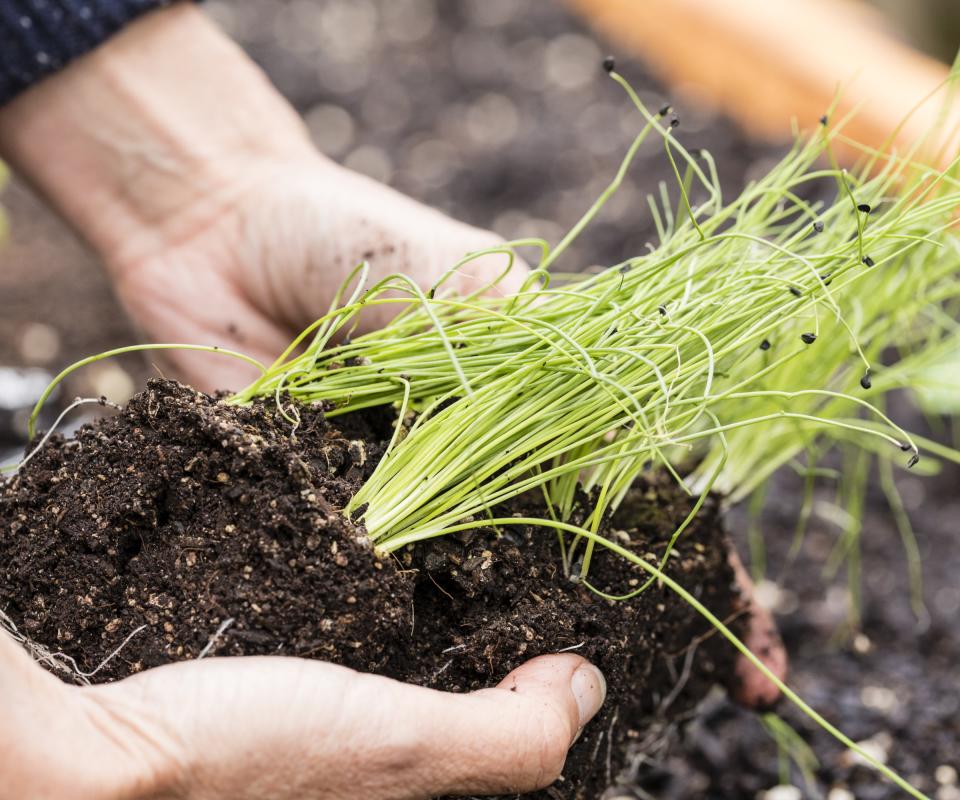
How to grow chives from seed
Chives can be sown indoors in early spring if you have a greenhouse or an indoor heated propagator. Fill a pot with good-quality seed compost and sprinkle the seeds over the surface before covering it with another thin layer of compost. Chives want a temperature of 68-77°F to germinate and the seedlings should appear within a few weeks.
Transplant the seedlings into individual pots when they are at least four inches tall and grow them on before planting them out into their final position in the kitchen garden or herb garden after the last frosts for your US hardiness zone. Always harden the young plants off before planting them outside.
After the risk of frosts has passed, chives can be sown directly into the ground once the soil temperature reaches 65°F. Weed the site and remove any large rocks before sowing chive seeds two inches apart in rows at least six inches apart. Water the area well and keep it moist, but not waterlogged, and the seedlings should appear quickly. Thin out the seedlings to an eventual spacing of 4-6 inches as they grow.
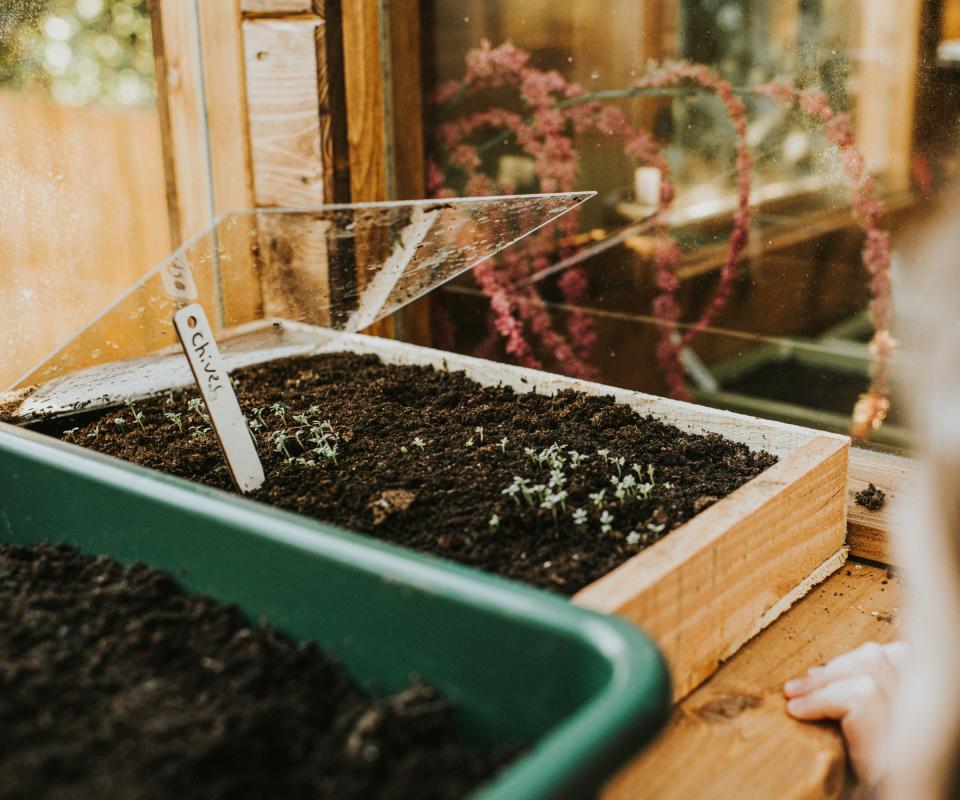
How to grow chives from cuttings
There is a very easy way to be able to propagate new plants for free from an existing chive clump. If you already have established clumps of chives then Lucy Chamberlain, fruit and vegetable growing expert for Homes & Gardens, advises that root division in spring or fall is a fantastic way to get more plants.
She says: ‘This is a quick way to bulk up clump-forming herbs such as chives. Slice congested clumps into sections, discard old, woody pieces and pot up healthy sections or plant elsewhere on the plot.’
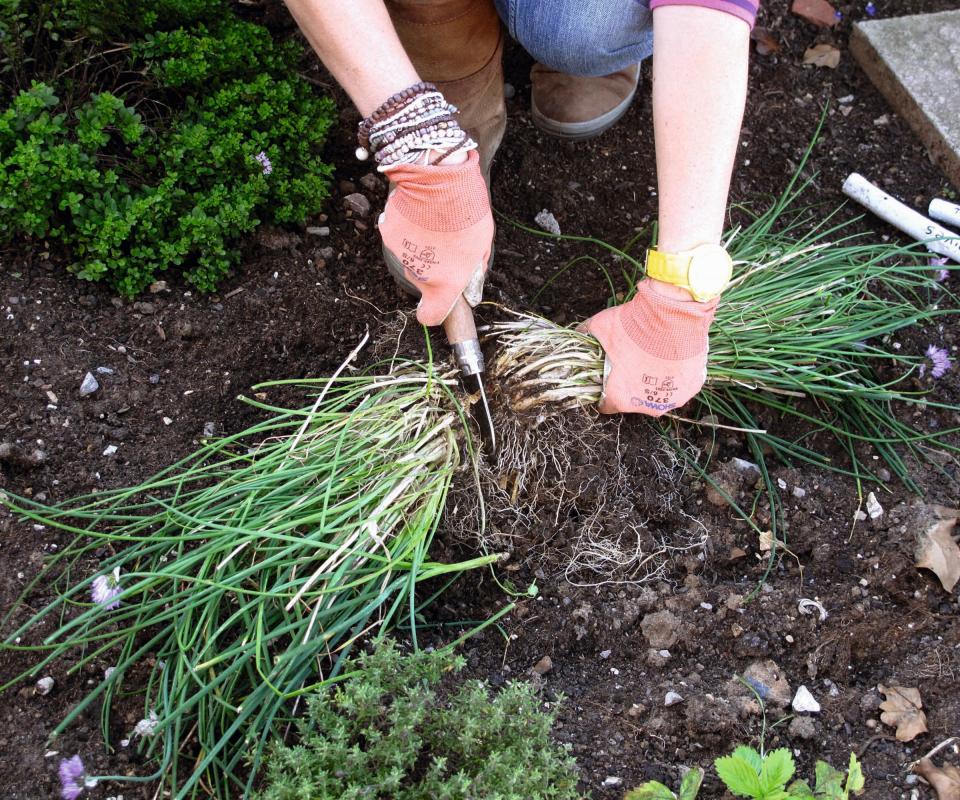
How to grow chives in a pot
If you are short of outdoor space, or looking to grow herbs on a patio or balcony, then growing herbs in pots is a great avenue to go down. Herbs are fantastic as part of container gardening ideas and chives are one herb ideally suited to herb planter ideas.
Bryan Clayton, an experienced gardener and landscaper and CEO of GreenPal, hails chives for their ability to ‘adapt well to container gardening’. He says: ‘Ensure the pot has adequate drainage and is at least 8 inches deep to accommodate their roots. Growing chives in pots can also be an advantage if you're looking to move them around to chase the sunlight.’
Make sure any planter has holes in the bottom for drainage to prevent the herbs from getting waterlogged and never consider using garden soil in pots as it is not suitable and liable to get too sodden during periods of wet weather.
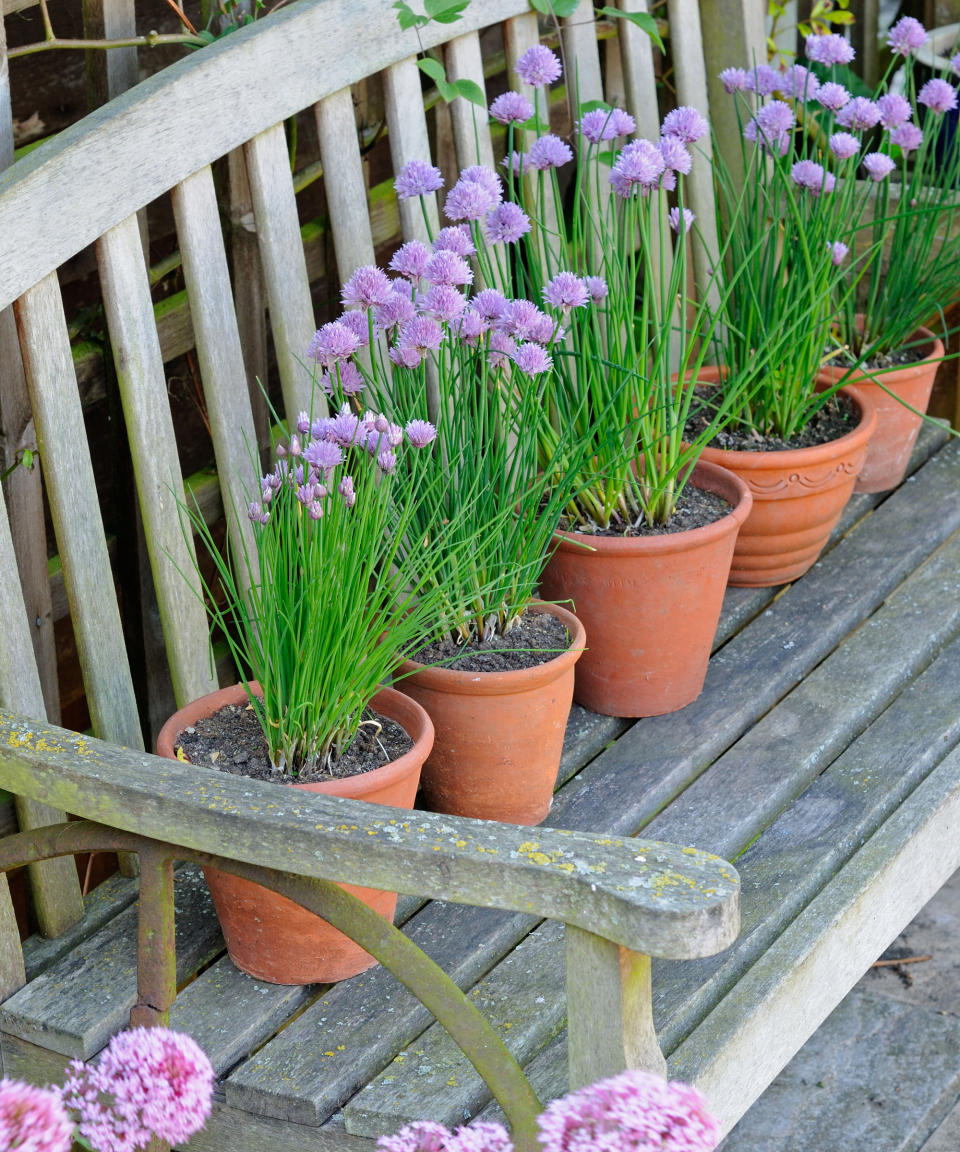
How to grow chives indoors
Chives can be grown indoors, so you can have a pot or two within arm's reach in the kitchen to use. When you dig up and separate clumps of existing chives, why not consider setting a couple aside to bring indoors to grow?
Plants need to be kept in a bright and sunny location, ideally one which offers around six to eight hours of sunlight. Additional artificial lighting may be required throughout the winter months, though chives will not grow much during these colder months.
If you want to grow herbs indoors you can either grow them from seed or buy young herb plants, but getting the light correct is a common mistake to avoid when growing herbs indoors. Too little light and the plants will be leggy and weak.
How to care for chives
Water chives well when they are newly planted and continue to keep them hydrated throughout the growing season, especially during periods of hot weather when they require plenty of moisture. Mulching around chive plants with a layer of compost, well-rotted manure, leaf mold, or grass clippings can help to retain moisture in the soil and add nutrients to the ground.
Lindsey Chastain advises: ‘The secret to great chives is providing regular water and occasional fertilizer. Keep soil moist but not soaked. Fertilize two-to-three times during spring and summer with a balanced liquid fertilizer.’
Keep plants well-weeded and regularly harvest chives from May until September to keep the plant productive as it encourages new growth. Chives are at their most flavorful fresh from the plant and stems should be cut around two inches above the soil.
Chive blooms are also edible, as well as great flowers that attract bees and other pollinators into a yard. Once the blooms have gone over it is advised to remove faded flower heads. This helps keep the plant neat as well as productive, as it prevents the plant from putting lots of energy into forming seeds.

Common chive problems
The good news is that chives are a fairly trouble-free perennial not usually bothered by many pests or diseases. The likes of aphids or greenflies can be an issue for chives, however, there are simple ways of getting rid of aphids. These include spraying them with a jet of water from a garden hose, making homemade bug sprays, or using insecticidal soap to treat them. You can get insecticidal soap from Amazon.
Leek rust is a problem with alliums. It is mainly an issue when growing leeks, as the name suggests, however, onions, garlic, and chives can also be affected. Bright orange spots will be identifiable on the leaves and it tends to hit from mid-summer onwards. Any affected foliage needs to be removed and destroyed.
If you do not harvest chives regularly enough then plants can become long and tatty, it can cause leaves to break and turn yellow. If this happens then cut the whole plant to two inches above ground level to allow fresh growth to come through and replace the tatty leaves. If your plant shows signs of spindly growth, it could be that the plants are in too much shade and need to move to a sunnier spot.
FAQs
How long do chives take to grow?
Chives are a relatively fast-growing plant and you can get a harvest very quickly. Chives are ready to crop around 30 days from when plants are transplanted out into the garden, while it can take 60 days to go from sowing the seed to getting a first harvest of leaves.
Do chives come back every year?
Chives are a perennial plant that will die back each winter and come back into growth come spring. They are cold hardy to US hardiness zone 3 and their clumps will enlarge in size each year, which is why it is good practice to regularly divide your chives. If you live in a particularly cold climate, then chives can be brought indoors to over-winter.
As well as their edible leaves and flowers, chives also serve a fantastic useful purpose in companion planting. Chives can deter many garden pests in a vegetable garden, benefitting the likes of carrots, tomatoes, and cucumbers, while it can also be helpful in flower beds as it helps protect roses from black spot.